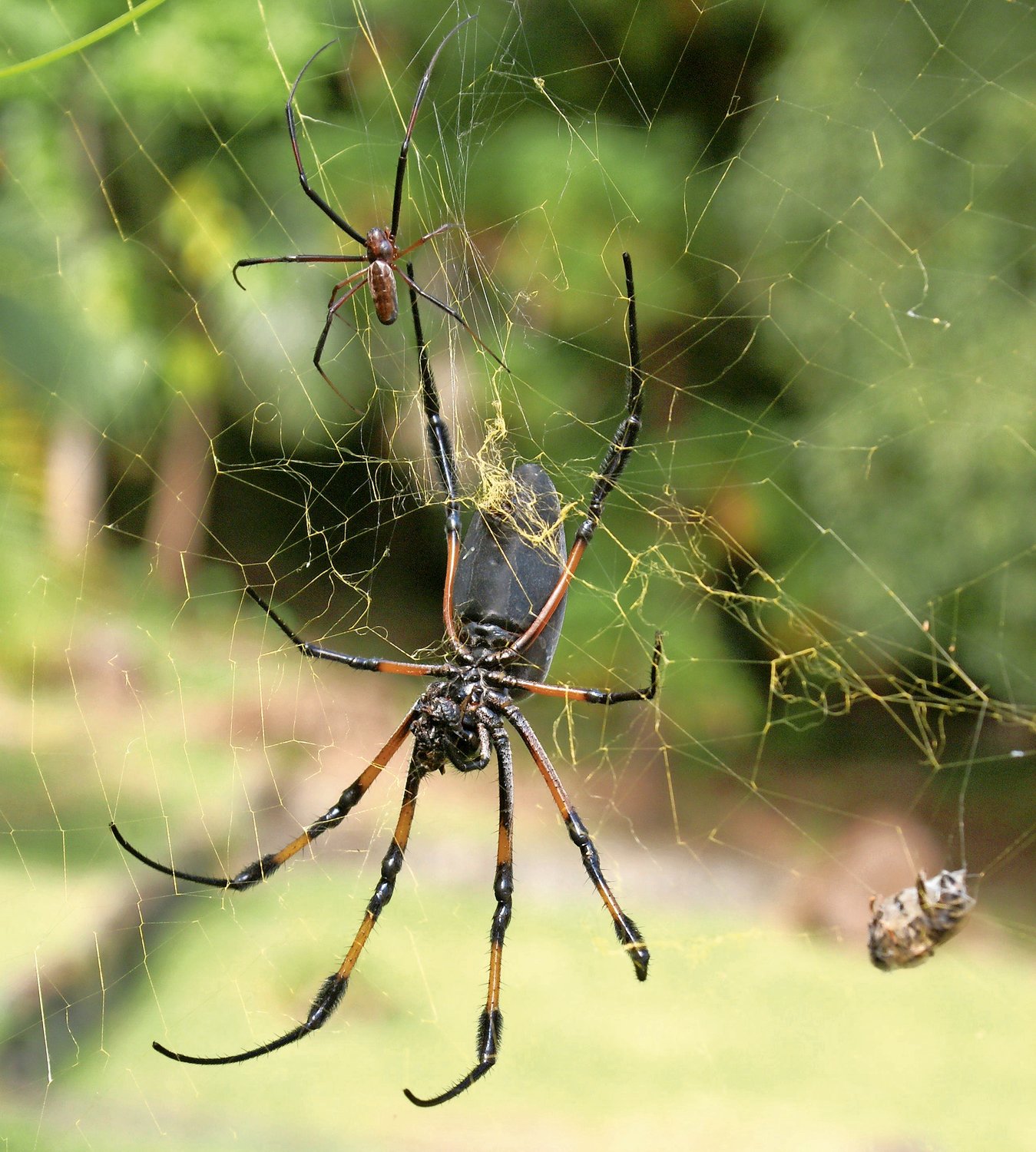Spiders may be scary, but they certainly contribute to society
Our pumpkin spider builds a new web every day. Because web silk is metabolically expensive, the spider eats its old web each evening before spinning a new one the next morning in order to conserve the protein content.
The webs of young spiders have more radii than more mature specimens. This may be because the spider uses its body as a measuring tool, and as the spider molts — allowing it to grow in size — its dimensions change and enlarge.
For example, the spacing between spirals is proportional to the distance from the tip of the spider’s back leg to the spinners on its abdomen from which the silk is extruded, making spirals further apart with age and size.
These spinnerets contain multiple microscopic spigots, each producing one type of thread. This way the spider can combine multiple strands in various combinations to serve different purposes.
Both males and females build webs, but the male’s web is not the intricate spiral of the female. The male abandons his when he starts searching for a mate.
Humans have had uses for spider webs like wound packing to stop bleeding. Polynesian and Madagascar fishermen have used some silks as fishing lines, and in New Guinea webs were used as rain hats.
During World War II, the threads of several orb weavers were used as hairs in measuring equipment.
The most idiosyncratic usage may have been by Anne Clopton of Alabama, who used cobwebs instead of canvas for her paintings.
The greatest challenge, however, has been to harvest and use the fiber in fabrics, also called gossamer, because of its strength and flexibility. Spiders make seven different silks for a multitude of purposes, but the silk of commercial and industrial interest is Major Ampullate or dragline silk, used to construct the hub and the web radii as well as the dragline.
It is made from spidroin proteins, part of a group of scleroproteins that are related to keratin and collagen. It’s soluble in water and is made up of three building blocks.
The longest section, found in the middle of each block, is a long series of repeats. There is a beginning segment and an ending segment. As the mixture is forced out of the spinners, it becomes more acidic, and this allows the proteins to hook into each other forming a long fiber.
Spiders cannot be farmed because they are cannibalistic and will eat each other. Therefore work described in the next section has involved various other organisms with introduced spider genes.
Bolt Threads is marketing ties made out of spider silk. When asked why the world needs a new fabric, the reply was that textile manufacture is one of the dirtiest industries in the world, causing 20 percent of the world’s water pollution.
Bolt Threads’ process involves using genetically modified yeast to produce the spider silk proteins. The sugars used by the yeast are presently derived from corn, but it is believed that the fermentation process could use other non-food stocks that are high in cellulose.
The quest to make fabric directly from spider silk began years ago. In 1709, Francois-Xavier Bon de Saint Hilaire of Montpelier, France, demonstrated that he could produce such a fabric eventually producing gloves, stockings and a full set of clothes for Louis XIV. He used spider cocoons — boiling, washing and drying them and collecting the fiber using fine combs.
His report, written in 1710, was republished and translated widely.
In the early 1800s, Jesuit priest Raimondo Maria de Termeyer discovered how to extract silk fiber directly from a female spider. He left a drawing of his machine, created in 1807.
The process involved clamping a spider on its back and drawing out the gossamer onto a reel.
From this he produced stockings for Napoleon Bonaparte and a shawl for Bonaparte’s wife, Josephine.
In 1896, entomologist Father Paul Camboue and his business partner M. Nogue expanded Termeyer’s work in Madagascar using the golden orb spider, Nephila inaurata, which extrudes a golden fiber. They produced silk bed hangings, which were exhibited at the Paris Exposition of 1898 and have since disappeared.
Today there are several new pieces of embroidered golden cloth woven from the threads of the golden orb spider. The first, an 11-by-4-foot tasseled fabric exhibited at the Museum of Natural History in 2009, and the second a golden cape exhibited in 2011 at the Victoria & Albert Museum in London.
These works were created by Simon Peers and Nicholas Godley in Madagascar. The cape required the contribution of 1.2 million spiders, which could only be milked during the rainy season.
Milkings took about 25 minutes, and then the creatures were returned to the wild to recharge. They could be used again in about a week.
Each milking could produce up to 500 yards, and it takes about 23,000 spiders to produce one ounce of silk. Each warp thread is created from 96 strands of spider silk, and the weft from 10 threads.
The finished pieces are absolutely glorious!
You never know where a chance observation will lead. It is claimed that the inspiration for E.B. White’s book , “Charlotte’s Web,” came about when the author noticed stabilimenta, a conspicuous ornamentalized area in the center of the web of some orb spiders, and realized that, theoretically, letters could be visible on such a structure.
Have a thought or comment for Sura Jeselsohn? Email her at greenscenesura@gmail.com.






